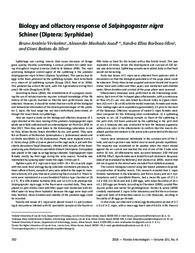Biology and olfactory response of Salpingogaster nigra Schiner (Diptera: Syrphidae).
Biology and olfactory response of Salpingogaster nigra Schiner (Diptera: Syrphidae).
Author(s): VERÍSSIMO, B. A.; AUAD, A. M.; SILVA, S. E. B.; SILVA, G. B. da
Summary: Summary Salpingogaster nigra is a promising species for biological control of the spittlebug Mahanarva spectabilis Distant (Hemiptera: Cercopidae). This study determined the biology of the immature stage, as well as aspects of S. nigra adult behavior. Female fertility, egg viability, and the duration and viability of the larval and pupal stages were evaluated. Behavioral aspects were studied by the olfactory response of mated females, with a Y-type olfactometer. We assessed predator response to spittlebug nymphs vs. clean air; spittlebug nymphs vs. spittlebug foam, and spittlebug foam vs. clean air. Female fecundity reached 25.1 ± 6.1 (SE) eggs per female per d, and egg viability was 64.0% ± 4.5%. Duration and viability of the larval period were 10.5 ± 0.4 d and 10.0 ± 2.1%, respectively. Duration of the pupal stage was 10.7 ± 0.2 d, and viability was 88.1% ± 5.1%. Significant preference was observed for odors from nymphs in contrast to clean air. Results show that although S. nigra adults, eggs, and pupae may be kept in the laboratory, the mass breeding of the predator presently is not feasible due to low larval viability.
Publication year: 2019
Types of publication: Journal article
Unit: Embrapa Dairy Cattle
Keywords: Brachiaria, Pastures, Predators
Observation
Some of Embrapa's publications are published as ePub files. To read them, use or download one of the following free software options to your computer or mobile device. Android: Google Play Books; IOS: iBooks; Windows and Linux: Calibre.
Access other publications
Access the Agricultural Research Database (BDPA) to consult Embrapa's full library collection and records.
Visit Embrapa Bookstore to purchase books and other publications sold by Embrapa.

